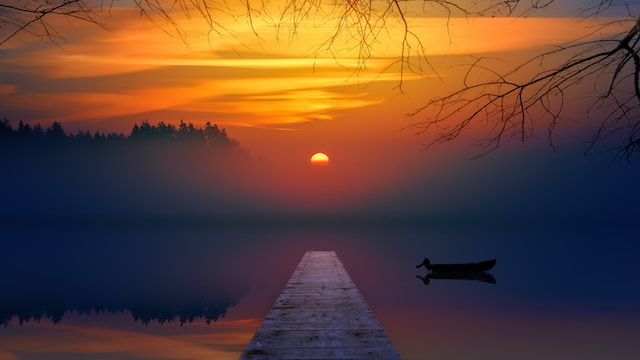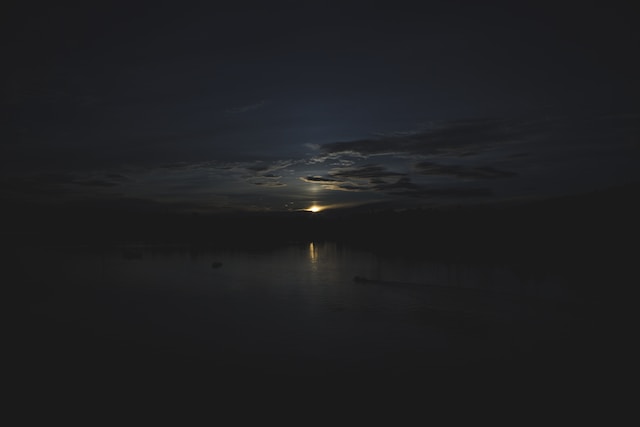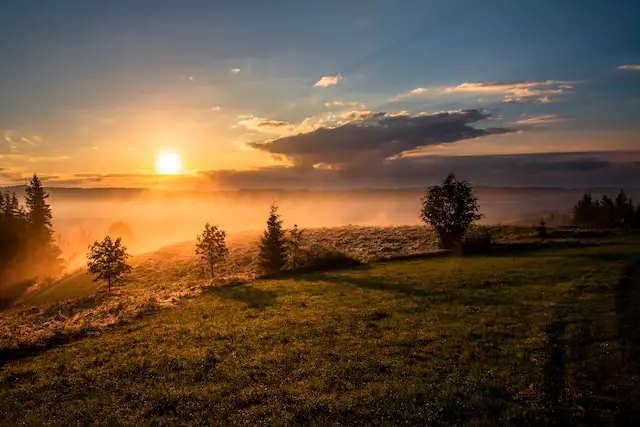Sunset refers to the moment when the top of the sun dips below the horizon, while last light is when all traces of sunlight have disappeared from the sky. The different types of sunsets and last lights can create a variety of stunning visuals in nature.
What is sunset?
(Photo by Johannes Plenio on Unsplash )

Sunset is a breathtakingly beautiful natural phenomenon that occurs when the sun dips below the horizon line. It’s a moment in time that symbolizes the end of another day and the start of something new. As sunlight passes through Earth’s atmosphere during sunset, it creates an array of colors in the sky – from warm oranges to deep reds – making for some truly amazing views.
The duration of sunset can vary depending on where you are and what time of year it is. For example, if you’re near the equator, your sunset might only last a few minutes due to how quickly the sun appears to dip below the horizon. However, if you’re closer to one of Earth’s poles, your sunset could last much longer because of how slowly the sun sets and rises again.
Regardless of its length or location, there’s no denying that watching a vibrant sunset is an unforgettable experience that has captured hearts and minds for centuries.
What is last light?
(Photo by Angel Luciano on Unsplash )

Last light is a term used to describe the period of time immediately following sunset. It refers to the final moments when the sun has completely disappeared below the horizon, but there is still residual light illuminating the sky. This twilight period lasts for about 30 minutes and varies depending on your location and time of year.
During last light, you can observe beautiful colors in the sky such as pinks, purples, oranges and reds. It’s an ideal time for photographers who want to capture stunning landscape shots with dramatic skies.
Aside from being visually stunning, last light also has practical uses like allowing pilots and sailors enough visibility to land or navigate during this transition phase between day and night.
It’s important not to confuse last light with dusk which is defined as complete darkness after sunset. While they are both related phenomena that occur around sunset hours – they have their own unique characteristics that make them different from each other.
Sunset Vs. Last light – Key differences
Sunset and last light are two terms that are often used interchangeably, but they actually refer to different moments in time during the transition from day to night. Sunset is the moment when the sun disappears below the horizon, while last light refers to the very last bit of visible sunlight before complete darkness sets in.
Sunset typically occurs around 10-15 minutes after the actual disappearance of the sun due to atmospheric refraction. During this time, there may still be some residual light in the sky, which can create beautiful colors and reflections on clouds or water bodies.
Last light, on the other hand, marks a more definitive end to daylight as it is directly tied to astronomical twilight – when even indirect sunlight is no longer visible. It’s worth noting that at higher latitudes during certain times of year (such as summer), there may not be any true “last light” due to extended periods of civil twilight.
Understanding these differences between sunset and last light can help you better plan your photography sessions or outdoor activities. By knowing exactly when each event will occur based on your location and time of year, you can make sure you capture those perfect shots or catch one final glimpse of natural beauty before darkness falls.
What are the 3 types of sunsets?
Sunsets are one of the most beautiful and romantic natural phenomena that we can observe. They occur when the sun goes below the horizon, creating a stunning display of colors in the sky ranging from reds to oranges, yellows, pinks and purples. However, not all sunsets are created equal – there are actually three different types!
The first type is called an “orange sunset”. This happens when there is a lot of dust or pollution in the air as sunlight passes through it. The result is a deep orange color that fills up the entire sky.
The second type is known as a “red sunset”. This occurs when weather conditions such as high pressure or low humidity create more particles in the atmosphere, which scatter light differently than usual. As a result, red hues dominate over other colors during sunset.
We have what’s called a “purple sunset”. These happen at higher latitudes or elevations where there’s less pollution present than usual. The combination of clean air with just enough moisture results in stunning purplish-pink skies during this time.
The different types of last lights
The term “last light” refers to the period of time just after sunset when the sun has fully disappeared below the horizon. During this time, there is still some ambient light in the sky that can create stunning visual effects.
One type of last light is known as civil twilight. This occurs immediately after sunset and lasts for about 30 minutes. During civil twilight, there is still enough sunlight to illuminate objects on Earth’s surface.
Another type of last light is nautical twilight which happens right after civil twilight ends, lasting approximately an hour. During this phase, navigation by stars becomes possible because they are visible against a dark blue background.
The third and final type of last light is astronomical twilight – occurring right before full darkness sets in – it lasts approximately one hour and allows astronomers to observe celestial objects without any interference from natural sources of illumination.
Each type offers unique opportunities for photographers looking to capture breathtaking shots at nightfall or stargazers aiming their telescopes towards distant galaxies amidst fascinating shades of purple and orange hues.
Is dusk, sunset or last light?
Dusk is a transitional period between day and night. It occurs right after sunset when the sun is still below the horizon but its rays continue to illuminate the sky. During this time, there’s still some light in the sky, but it’s not as bright as during daytime.
While dusk may seem similar to both sunset and last light, it’s important to note that they all have distinct differences. Sunset marks the exact moment when the upper edge of the sun disappears behind the horizon, while last light refers to when there’s no direct sunlight left in a particular location.
In comparison, dusk can be seen as a period of fading light where everything starts moving from daylight towards complete darkness. The duration of dusk varies depending on your geographical location and time of year.
Dusk is often considered an ideal time for photography because of its soft natural lighting that creates stunning silhouettes and shadows. Additionally, many animals become active during this period making it an excellent window for wildlife watching.
So while at first glance dusk might appear similar to sunset or last light – it’s actually quite different in terms of definition and experience.
What is morning golden hour called?
The golden hour is a term used to describe the time of day when the sun is low in the sky and creates a warm, glowing light. This light can be especially beautiful during sunrise or sunset, but did you know that there’s also a term for the same effect that occurs in the morning?
The morning version of the golden hour is called “the blue hour.” It typically occurs just before sunrise and gets its name from the blue tones that are present during this time. Like with sunset, certain weather conditions can make this period even more stunning – think misty mornings or clear skies after rain.
During this time, photographers often take advantage of the soft, diffused light to capture stunning shots. The peaceful stillness of early morning combined with these beautiful colors can create a truly magical atmosphere.
So next time you’re up early enough to catch it, keep an eye out for the blue hour – it might just become your new favorite time of day!
Featured Image By – Dawid Zawiła on Unsplash








